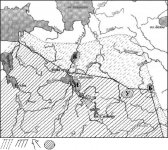Norvila
Regular Member
- Messages
- 98
- Reaction score
- 4
- Points
- 0
- Y-DNA haplogroup
- N1c1
- mtDNA haplogroup
- U5b2a1
There is interesting results from Polish Y-DNA Haplogroup Summary Table (please google).
LTNQ 6.9% N (M231) 5.2% N-L550 5.0% N-M2783 4.6% N-Z16975 1.9% N-Z16981 1.1%
So 6,9% out of 38,53M population is 2.659M N1C1.
I think it's more than LT+LV+EE N1C1 all together.
Calculating in absolute figures I came to conclusion there are more N1C1 people in PL+LT+LV+EE than in FI.
Should be this haplogroup called South East Baltic?




